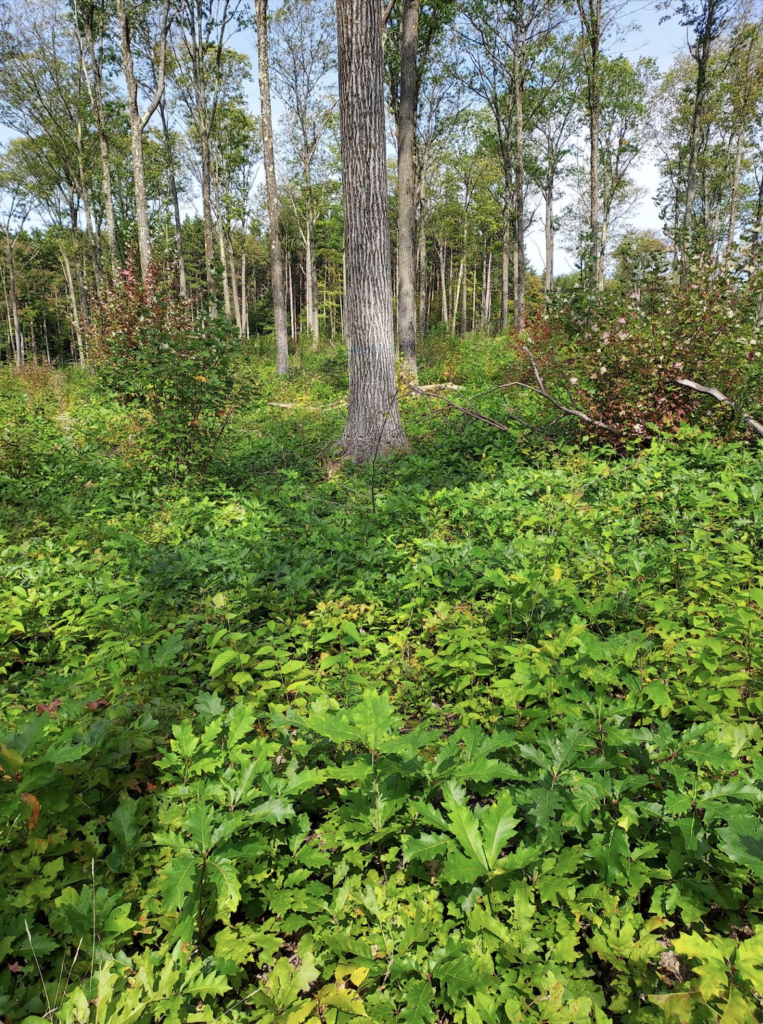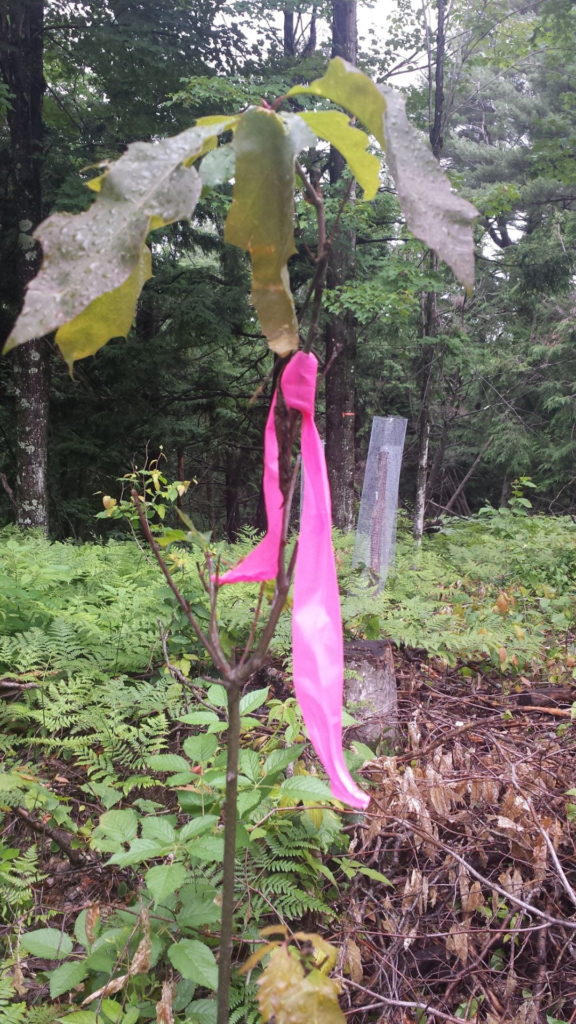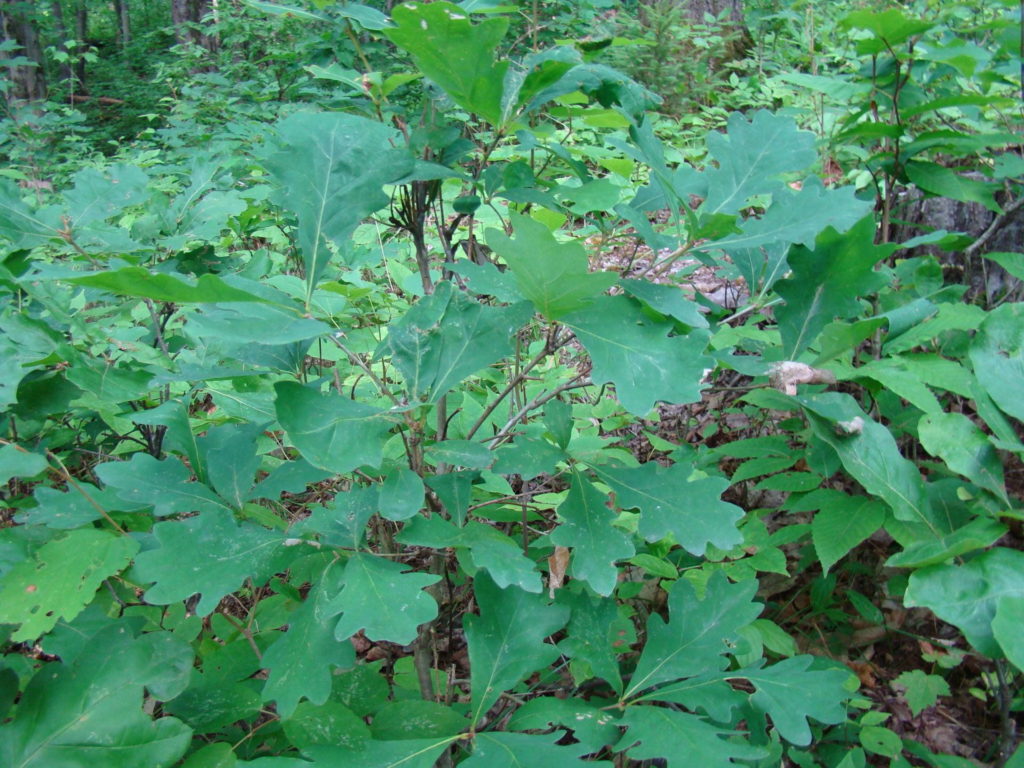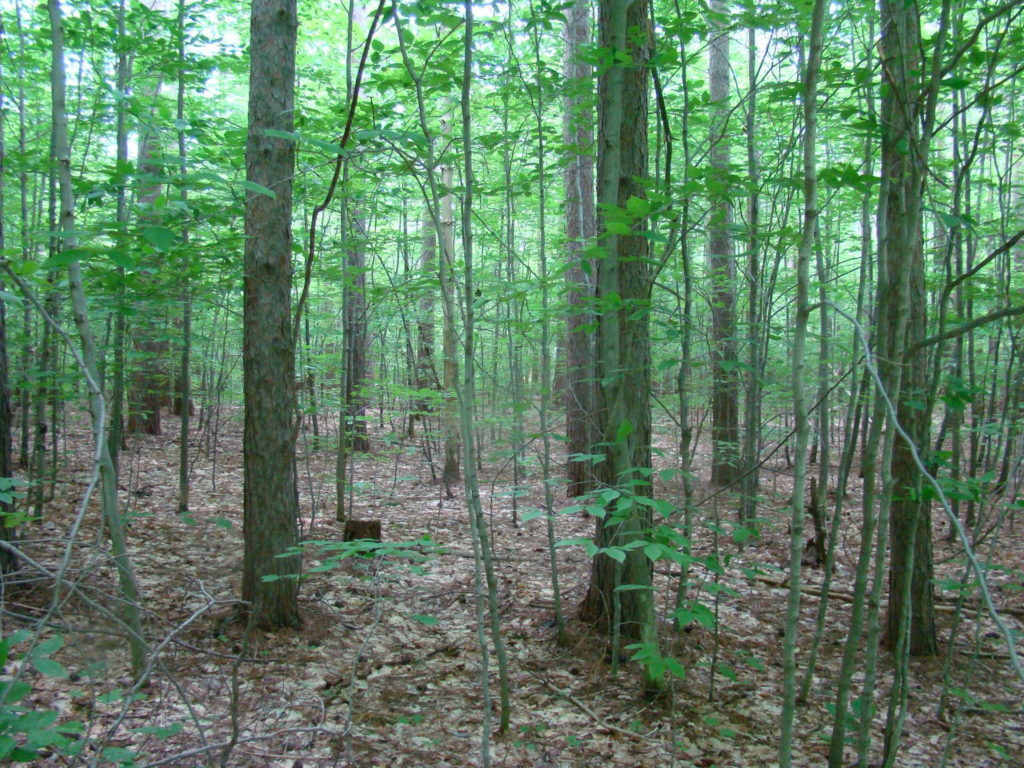Anticipating the Next Forest: Ecology and Management for Sustaining Forests
Consider a long-term time frame to think about private forests specifically and broadly; how they used to look, how they have changed, and visualize what future private forests will provide to future owners.
By Peter Smallidge and Gary Goff
Periodically, maple producers and woodlot owners should pause and consider their woods, both their sugarbush and their other woodlands. Consider a long-term time frame to think about private forests specifically and broadly; how they used to look, how they have changed, and visualize what future private forests will provide to future owners.
For most of our private woodlands, the soil will continue to grow plants. The question though is whether those future plants will provide the variety of benefits that the owners desire, including products for sale and ecological services and values that forest owners provide to society. The process of forest regeneration, if and how it happens, will determine what we can anticipate in the future forest.

A robust seedling layer developed in an oak shelterwood harvest inside a slash wall at Cornell’s Arnot Forest. The harvest coincided with a year of abundant acorns, and the seedlings were protected from deer.
Several recent studies, and some not so recent, have called attention to the problem within some forests to regenerate desired species to provide the next forest. To highlight some recent information: (1) A study in which we participated surveyed foresters about their observations from the most recent stand (a working unit of the forest) they visited that should be capable of regenerating. These foresters reported moderate or successful regeneration in only 30% of those stands; a 70% failure rate. Successful regeneration was defined as desirable species at least 5 feet in height. (2) A study by The Nature Conservancy, based on a review of US Forest Service data, used a regeneration index and found that timber species were regenerating on 43% of permanent monitoring plots. (3) Dr. Ralph Nyland reported in a ForestConnect webinar in February 2009 that the overwhelming predominance of exploitive cutting has often led to failed regeneration or significant complications with the regeneration process. These three independent assessments all concluded that northeastern hardwood forests are facing a concerning future. Other barriers, such as invasive earthworms and soil acidity further complicate forest regeneration in some locations.
A bit of context and background
In a simplistic way, we can think of the forest as two layers; the upper canopy and the understory. In forests less than about 40 to 50 years of age, we seldom worry about understory layer of desired species of seedlings, or advanced regeneration, because the forests have a long time horizon. At about 75-100 years old however, the anticipation for regeneration should heighten because some tree species may be approaching the end of their life cycle and/or sawtimber species maybe financially mature. At this point in a stand’s development any natural or human-induced disturbance of the upper canopy will provide sunlight to the plants in or on the forest floor and favor their expansion and abundance. An ice storm or prolonged insect defoliation, for example, might not fully destroy the overstory, but could provide sunlight to establish a dominating understory. A dominating understory is good if it has a mixture of desired quality seedlings. Unless the understory is changed, the species present at the time of a canopy disturbing event will most likely become the next forest. Generally, “what you see is what you get.”
Trees, shrubs, and herbaceous plants reproduce by distributing propagules such as seeds or spores, or by vegetative propagation (sprouts) from their roots or stems. Almost all plant species have the ability to distribute propagules, relatively fewer will reproduce through vegetative methods. Successful reproduction of a plant requires the propagule or vegetative structure plus an adequate environment for the new plant to become established and survive long enough to reproduce itself.
As woodlot owners, and maple producers, trees are a significant part of our interest in the woods. As the forest grows we can harvest the volume of some trees that would otherwise die, and we may eventually plan for the re-establishment of large sections of our forest. Timber harvests and thinning in the sugarbush and woods must be sustainable to ensure continued flow of products and forest services. Regeneration of new young-aged seedlings is the first step in sustainability. Failure to ensure appropriate numbers (often thousands of stems per acre), sizes and growth of desired species may disappoint some forest owners and may erode the confidence of society in our capacity for responsible and sustainable forestry. Regeneration thus requires that new trees become established, the number of stems per acre is appropriate, those new trees represent the desired mixture of species, and stems have a quality that will provide for future desired products

Red oak seedlings are desired by many owners for timber, fuel, wildlife and aesthetics. The seedling in foreground is heavily browsed, deformed, and stunted. A tree caged, in background, is one example of a deer exclusion tactic that is effective for efforts to protect a few stems on a few acres.
Tree regeneration, our focus here, requires the coincidence of (i) the availability of propagules or seeds, (ii) the receptivity of the site (the seed bed) for the seedling to become established, and (iii) adequate growing conditions at the site for the seedlings to grow toward maturity. If the timing or quality of one of these three factors doesn’t align, regeneration typically fails. Trees may require years to become sexually mature and that owners may need to conduct specific management activities to create an appropriate seed bed and growing conditions. Thus, regeneration is a process through time.
As a forest approaches maturity, there are tipping points beyond which successful regeneration become less assured and likely more costly. If a seed source is absent due to exploitive or selective logging, such as diameter limit cutting or high-grading, regeneration of desire species is significantly more difficult. The presence of deer that exceed the carrying capacity of the woods requires some strategy to reduce or remove their impact or regeneration efforts will fail. Note that the actual number of deer per square mile is less or unimportant, rather it is the abundance of deer relative to the forage base and carrying capacity. Finally, the selective browsing by deer can eliminate the desired species (deer and humans both seem to prefer the same species) and promote an understory of undesired trees and shrubs that inhibit trees even if deer are removed and which can be difficult to remove.
Why do we care about tree regeneration?
Trees define the forest. Given pressures in the forest (see below), doing nothing may lead to disappointing outcomes. Some owners started a forest from scratch in a former pasture, and some owners assumed responsibility for the trees present when they became the owner. For the tenure of most owners, they will tend, or manage, and utilize one age-group of trees on any given acre. As trees are utilized, or the forest is otherwise disturbed, resources become available for new trees and plants to establish. Owners will chose whether they will invest or not in helping to ensure that the next forest provides future owners with a comparable suite of opportunities. Woodlot owners from the full spectrum of interests will benefit from attention to regeneration of diverse and healthy forests.
When forest trees do not regenerate, through short and long time frames, the quality of the forest, and the opportunities it offers the owner, may decline. If we first consider the human benefits associated with trees, the lack of regeneration may change aesthetic qualities, habitat for hunting, and over a multi-decade time frame the lack of forest products that provide revenue and local jobs. The future success of timber production, maple syrup production, wildlife mast trees for hunters, and fence posts depends on the level of success of the regeneration process.
Many species of wildlife benefit from successful regeneration. In a mature forest, the presence of desirable forest tree seedlings is important to maintain micro-environmental conditions. These mature forest seedlings also provide nutritious browse, nesting habitat, and escape cover. Other wildlife species depend on different environmental conditions provided by successful regeneration in early successional habitats. An important consideration for wildlife is that the unique growth form and fruit production of various plant species makes them more or less suitable for various wildlife species. Because of deer pressure (more on this topic later), some unpalatable plant species can dominate and the habitat can become unsuitable for some desired wildlife.
What limits forest tree regeneration? Why is there a problem?
Trees are long-lived and some forest owners may call a forest home for multiple decades and legitimately not

Deer require approximately 7 lbs (fresh weight) of forage per day. One estimate calculated 600 seedling tips per pound or 4200 seedling tips per deer per day. At this impact, deer are a profound force in the forest.
become involved in the process of forest regeneration. In a section of woods, barring any manipulations to the canopy or seed bed, the number of trees will decline through time. The remaining trees are the same stems, though larger, as when these owners started. In many ownerships, anytime an opening is made in the forest canopy and the forest floor has a prolonged exposure to sunlight, a new plant may become established. But, is it the plant that will serve the needs and desires of the owners, or one that might interfere? In this case, numbers matter and a few desired or undesired stems don’t matter much, though invasive plants can acheive seed output of hundreds of thousands per plant per year.
Recall the earlier discussion about the necessary timing and overlap for propagules, seed bed, and seedling establishment and growth. Any constriction on any of these three conditions can limit successful regeneration. Some constrictions or barriers are common but infrequent or of short duration. Also, if the site provides only limited soil (e.g., droughty, overly acidic, poorly drained) or light resources, typically only a few plant species have adaptations to survive in those conditions. The list of potential barriers to regeneration is immense. Barriers include chronic and episodic events such as late frosts that damage tree flowers, a peak in the woodland vole population that eats the seeds, an overly wet spring and widespread damping-off fungus, an outbreak of forest tent caterpillars that reduces tree energy reserves, and more. However, there are three primary factors that restrict desirable regeneration when they occur as sustained and widespread phenomena; other factors may develop as our environment changes.

What you see is what you get. American beech has become established and dominant in the understory of this 80 year old red pine plantation. Without owner intervention, the next forest is likely to become a beech forest.
First, most woodlands lack sufficient browse to support the resident deer herd. In these cases, deer disproportionately consume desired seedlings. Deer limit the adequacy of the seedling’s environment to grow and develop. Deer consume palatable seedling species, usually the most desirable for human needs, and avoid the less palatable species. This selective pressure results in a reduction in species diversity and a shift in the mixture of species. Other than beech and in some circumstances black cherry, deer will preferentially browse the seedlings of all our upper canopy tree species (e.g., oaks, maples, cherry, ash, basswood, pine, black locust, walnut). Visualize this process through time; each year the seedlings of desirable upper canopy trees are consumed and less desired species (e.g., multiflora rose, hophornbeam, striped maple, autumn olive, American beech) are retained. Consequently, any sunlight favors the growth of the less desired species. The impacts of deer on forest regeneration can be limited by controlling the number of deer or restricting the access of deer to desirable seedlings.
Recreational hunting is often suggested as a solution to the impact of deer. Most deer populations are sufficiently abundant that 40% to 60% of the herd must die (e.g., hunting, cars, disease, etc.) for the population to stabilize. Population reduction would require even greater mortality. A few isolated examples exist where hunting has sufficiently coordinated and regulated to allow for forest regeneration. However, most recreational hunting is insufficient to reduce deer impact. Current demographic trends of hunters and parcelization of rural lands suggest the inefficiency of hunting will accelerate not reverse. Most land managers and owners need a near-term solution, so discussions of releasing wolves and changing state and federal policy are entertaining but unrealistic for current management needs.
Second, most tree species require a specific quality and quantity of light for the seeds to germinate and the seedlings to develop. This is known as the shade tolerance of that species. Shade originating near the ground limits the suitability of the seed bed and the adequacy of the seedling’s environment. Dense understories of shrubs, grasses and ferns (often what the deer leave behind) will absorb the energy-rich red wavelengths and allow predominately the lower quality far-red wave lengths to pass. This lower quality and quantity of light prevents some seeds from germinating and some species from surviving. Understories of shrubs, subcanopy trees, grasses, sedges and ferns that intercept light and inhibit tree regeneration are collectively called interfering vegetation. Less desired species that commonly interfere with desirable hardwoods include American beech, striped maple, hophornbeam, ferns, grasses, sedges, and in some cases raspberry. Note that these species are not inherently bad. Rather, they have an important ecological role in the forest, but their avoidance by deer results in an imbalance among species. In some areas, non-native shrubs can play a similar role, species such as multiflora rose, bush honeysuckle, European buckthorn, glossy buckthorn, autumn olive, and Japanese barberry. In efforts to establish desired species of seedlings or wildflowers, dense and abundant understories of interfering vegetation need to be reduced to prevent them from reducing light quality and quantity.
Finally, because tree regeneration depends primarily on seeds, parent trees of appropriate genetic quality need to be present or have been recently present. Often however, as described by Dr. Nyland, exploitive cutting removes the best quality and largest trees and shifts the potential for seed production to fewer species of poorer quality and capacity to produce seed. Exploitive cutting, also known as high-grading, has the potential to eliminate some species from a stand and thus prevents that species from providing propagules and effectively regenerating. In some circumstances, such as a properly executed clearcut, seed and propagules are known to be in the soil seed bank or available from adjacent trees and seedlings establish successfully after the overstory is removed. Exploitive cutting is distinct from clearcutting; the high-grading activity will typically limit owner options for regeneration. When properly applied, clearcutting will ensure that seeds or propagules are available to result in adequate numbers of seedlings per acre to regenerate the harvested area. Owners who have acquired a high-graded forest will need to find good technical assistance to provide for desirable tree regeneration.
Recommendations
Deer – recreational hunting is a time honored and important cultural practice. In previous decades and in some specific areas hunting pressure is sufficient to truly impact deer abundance. However, in most areas recreational hunting is insufficient. Owners and managers will need to find a way to exclude deer. Cornell’s Arnot Forest has demonstrated the effectiveness of slash walls as a novel and cost-effective exclusion technique (www.slashwall.info) Other deer exclusion techniques are available, and all have cost and success attributes that dictate which is the best for a given situation. The presence of deer impact will often result in challenges from interfering vegetation.
Interfering vegetation – in most situations the presence of interfering vegetation is a result of prolonged and extensive deer impacts. It is futile to manage the vegetation without also managing the deer, although sequence might vary with the circumstances. Similarly reducing deer impact, through effective hunting or exclusion, typically requires disturbance of the interfering vegetation to reallocate sunlight to desired species. Numerous resources are available on methods to control interfering vegetation and forest vegetation management (www.youtube.com/ForestConnect).
Exploitive harvesting – exploitive harvesting, thoroughly applied, can take decades to correct. If possible, avoid this activity by being informed, asking questions and working with foresters and loggers who have a commitment to sustaining forest systems. That commitment may require that your revenue is less in the short run. If you inherit an exploited woodland, you will need to work through a process of allocating sufficient sunlight to desired species (even of poor growth form). At the same time, limit the impacts of deer and interfering vegetation.
Unfortunately, these barriers (and maybe others) occur on many privately owned woods in the Northeast and Midwest. Participate in your local forest owner or maple producer association woodland tours to learn how others are solving the process of regeneration. In some cases, you may need to encourage them to be deliberate in their solutions rather than just “hope” for success.
This article was expanded and adapted from the September-October issue of the 2012 New York Forest Owner 2012 magazine (www.nyfoa.org) at the onset of NYFOA’s Restore New York Woodland initiative.

